Math formula
Catalan numbers are defined using below formula:
Catalan numbers can also be defined using following recursive formula.
The first few Catalan numbers for n = 0, 1, 2, 3, … are 1, 1, 2, 5, 14, 42, 132, 429, 1430, 4862, …
Implementation
recursive version
#include <iostream>
using namespace std;
// A recursive function to find nth catalan number
unsigned long int catalan(unsigned int n)
{
// Base case
if (n <= 1)
return 1;
// catalan(n) is sum of
// catalan(i)*catalan(n-i-1)
unsigned long int res = 0;
for (int i = 0; i < n; i++)
res += catalan(i) * catalan(n - i - 1);
return res;
}
// Driver code
int main()
{
for (int i = 0; i < 10; i++)
cout << catalan(i) << " ";
return 0;
}
Time Complexity: O (2^n) The above implementation is equivalent to nth Catalan number.
The value of nth Catalan number is exponential which makes the time complexity exponential.
Auxiliary Space: O(n)
dynamic programming version
We can observe that the above recursive implementation does a lot of repeated work. Since there are overlapping subproblems, we can use dynamic programming for this.
Below is the implementation of the above idea:
- Create an array
catalan[]for storingithCatalan number. - Initialize,
catalan[0]andcatalan[1] = 1 - Loop through
i = 2to the given Catalan numbern.- Loop through
j = 0toj < iand Keep adding value ofcatalan[j]*catalan[i – j – 1]intocatalan[i].
- Loop through
- Finally, return
catalan[n]
Follow the steps below to implement the above approach:
#include <iostream>
using namespace std;
// A dynamic programming based function to find nth
// Catalan number
unsigned long int catalanDP(unsigned int n)
{
// Table to store results of subproblems
unsigned long int catalan[n + 1];
// Initialize first two values in table
catalan[0] = catalan[1] = 1;
// Fill entries in catalan[] using recursive formula
for (int i = 2; i <= n; i++) {
catalan[i] = 0;
for (int j = 0; j < i; j++)
catalan[i] += catalan[j] * catalan[i - j - 1];
}
// Return last entry
return catalan[n];
}
// Driver code
int main()
{
for (int i = 0; i < 10; i++)
cout << catalanDP(i) << " ";
return 0;
}
Time Complexity: O(n^2)
Auxiliary Space: O(n)
Binomial Coefficient Solution
We can also use the below formula to find nth Catalan number in O(n) time.
In the pascal triangle,
1
1 1
1 2 1
1 3 3 1
1 4 6 4 1
1 5 10 10 5 1
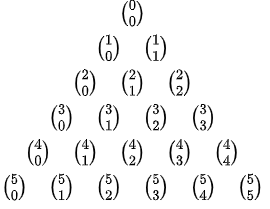
the formula for a cell of Pascal’s triangle:
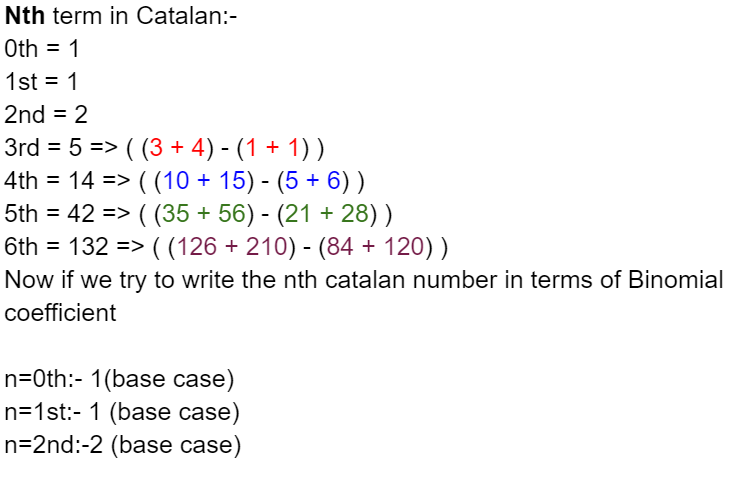
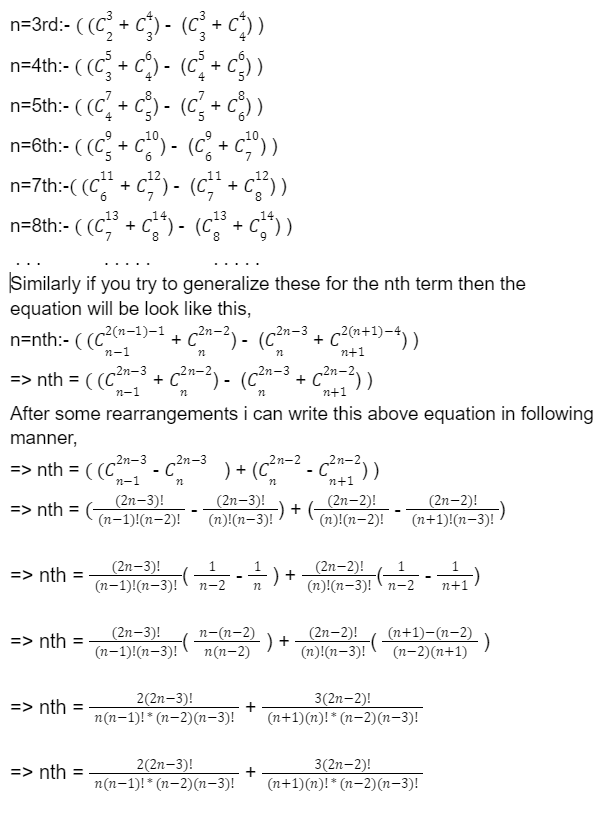
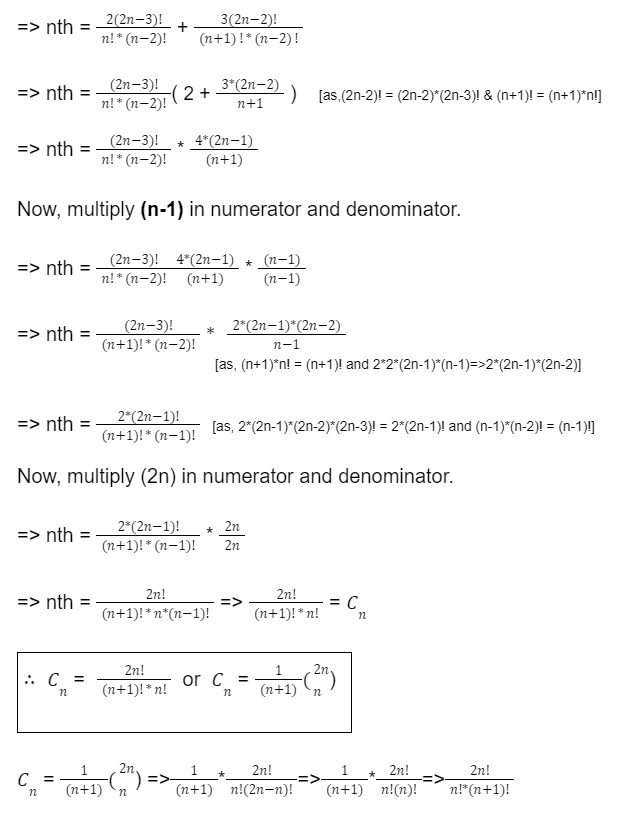
Below are the steps for calculating .
- Create a variable to store the answer and change r to n – r if r is greater than n – r because we know that C(n, r) = C(n, n-r) if r > n – r
- Run a loop from 0 to r-1
- In every iteration update ans as *(ans(n-i))/(i+1)**, where i is the loop counter.
- So the answer will be equal to ((n/1) * ((n-1)/2) * … * ((n-r+1)/r), which is equal to .
Below are steps to calculate Catalan numbers using the formula: 2nCn/(n+1)
- Calculate using the similar steps that we use to calculate
- Return the value
Below is the implementation of the above approach:
// C++ program for nth Catalan Number
#include <iostream>
using namespace std;
// Returns value of Binomial Coefficient C(n, k)
unsigned long int binomialCoeff(unsigned int n,
unsigned int k)
{
unsigned long int res = 1;
// Since C(n, k) = C(n, n-k)
if (k > n - k)
k = n - k;
// Calculate value of [n*(n-1)*---*(n-k+1)] /
// [k*(k-1)*---*1]
for (int i = 0; i < k; ++i) {
res *= (n - i);
res /= (i + 1);
}
return res;
}
// A Binomial coefficient based function to find nth catalan
// number in O(n) time
unsigned long int catalan(unsigned int n)
{
// Calculate value of 2nCn
unsigned long int c = binomialCoeff(2 * n, n);
// return 2nCn/(n+1)
return c / (n + 1);
}
// Driver code
int main()
{
for (int i = 0; i < 10; i++)
cout << catalan(i) << " ";
return 0;
}
Time Complexity: O(n).
Auxiliary Space: O(1)
Applications
- Number of possible Binary Search Trees with n keys.
- Number of expressions containing n pairs of parentheses which are correctly matched. For n = 3, possible expressions are ((())), ()(()), ()()(), (())(), (()()).
- Number of ways a convex polygon of n+2 sides can split into triangles by connecting vertices.
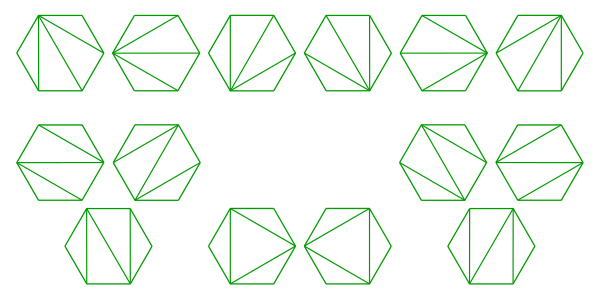
- Number of full binary trees (A rooted binary tree is full if every vertex has either two children or no children) with n+1 leaves.
- Number of different Unlabeled Binary Trees can be there with n nodes.
- The number of paths with 2n steps on a rectangular grid from bottom left, i.e., (n-1, 0) to top right (0, n-1) that do not cross above the main diagonal.
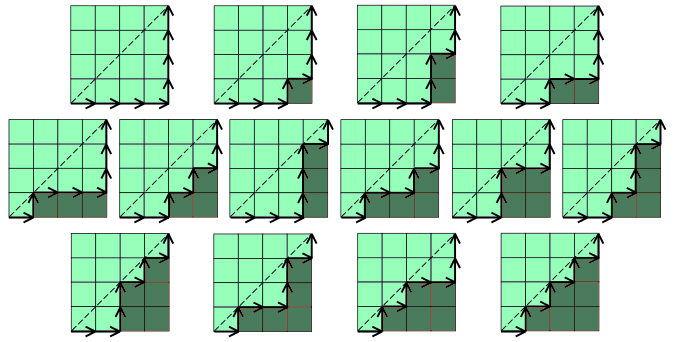
- Number of ways to insert n pairs of parentheses in a word of n+1 letters, e.g., for n=2 there are 2 ways: ((ab)c) or (a(bc)). For n=3 there are 5 ways, ((ab)(cd)), (((ab)c)d), ((a(bc))d), (a((bc)d)), (a(b(cd))).
- Number of noncrossing partitions of the set {1, …, 2n} in which every block is of size 2. A partition is noncrossing if and only if in its planar diagram, the blocks are disjoint (i.e. don’t cross). For example, below two are crossing and non-crossing partitions of {1, 2, 3, 4, 5, 6, 7, 8, 9}. The partition {{1, 5, 7}, {2, 3, 8}, {4, 6}, {9}} is crossing and partition {{1, 5, 7}, {2, 3}, {4}, {6}, {8, 9}} is non-crossing.
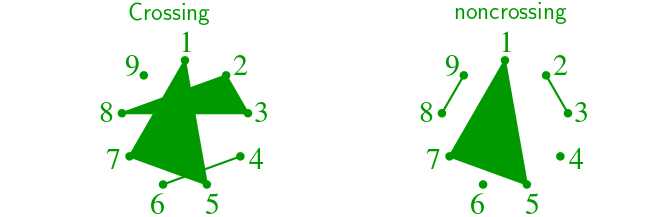
- Number of Dyck words of length 2n. A Dyck word is a string consisting of n X’s and n Y’s such that no initial segment of the string has more Y’s than X’s. For example, the following are the Dyck words of length 6: XXXYYY XYXXYY XYXYXY XXYYXY XXYXYY.
- Number of ways to tile a stairstep shape of height n with n rectangles. The following figure illustrates the case n = 4:

- Given a number n, return the number of ways you can draw n chords in a circle with 2 x n points such that no 2 chords intersect.
- Number of ways to form a “mountain ranges” with n upstrokes and n down-strokes that all stay above the original line.The mountain range interpretation is that the mountains will never go below the horizon.
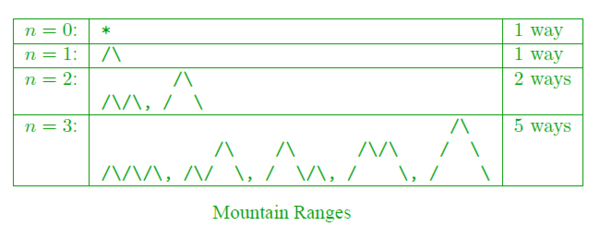
- Number of stack-sortable permutations of {1, …, n}. A permutation w is called stack-sortable if S(w) = (1, …, n), where S(w) is defined recursively as follows: write w = unv where n is the largest element in w and u and v are shorter sequences, and set S(w) = S(u)S(v)n, with S being the identity for one-element sequences.
- Number of permutations of {1, …, n} that avoid the pattern 123 (or any of the other patterns of length 3); that is, the number of permutations with no three-term increasing subsequence. For n = 3, these permutations are 132, 213, 231, 312 and 321. For n = 4, they are 1432, 2143, 2413, 2431, 3142, 3214, 3241, 3412, 3421, 4132, 4213, 4231, 4312 and 4321